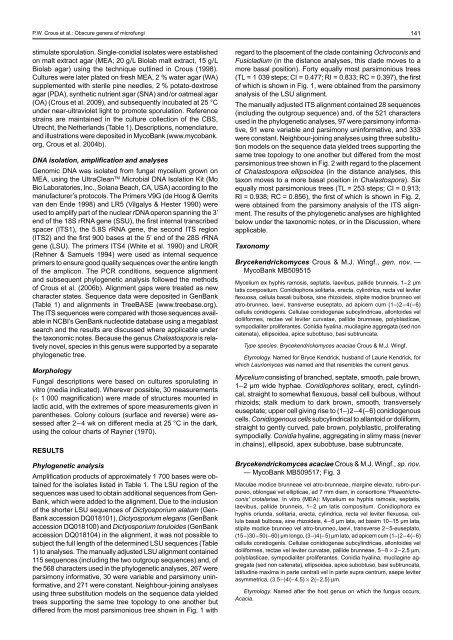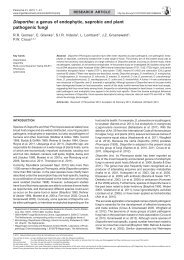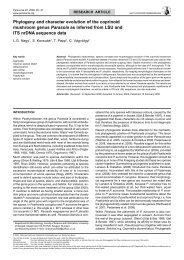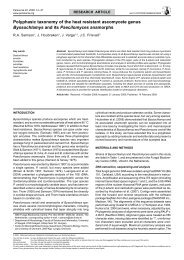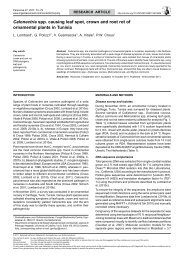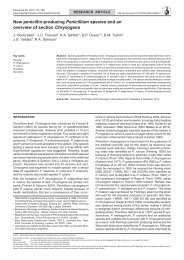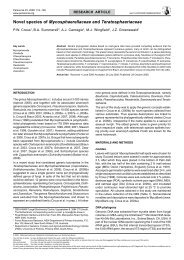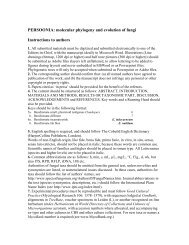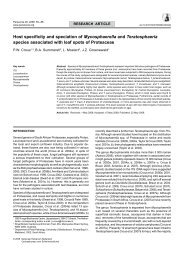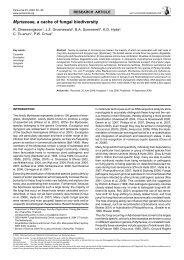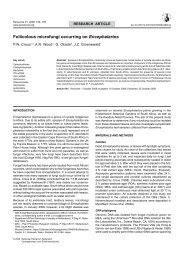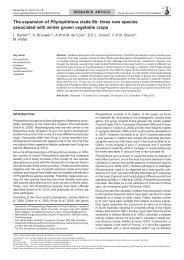Phylogeny and taxonomy of obscure genera of microfungi - Persoonia
Phylogeny and taxonomy of obscure genera of microfungi - Persoonia
Phylogeny and taxonomy of obscure genera of microfungi - Persoonia
You also want an ePaper? Increase the reach of your titles
YUMPU automatically turns print PDFs into web optimized ePapers that Google loves.
P.W. Crous et al.: Obscure <strong>genera</strong> <strong>of</strong> micr<strong>of</strong>ungi<br />
141<br />
stimulate sporulation. Single-conidial isolates were established<br />
on malt extract agar (MEA; 20 g/L Biolab malt extract, 15 g/L<br />
Biolab agar) using the technique outlined in Crous (1998).<br />
Cultures were later plated on fresh MEA, 2 % water agar (WA)<br />
supplemented with sterile pine needles, 2 % potato-dextrose<br />
agar (PDA), synthetic nutrient agar (SNA) <strong>and</strong>/or oatmeal agar<br />
(OA) (Crous et al. 2009), <strong>and</strong> subsequently incubated at 25 °C<br />
under near-ultraviolet light to promote sporulation. Reference<br />
strains are maintained in the culture collection <strong>of</strong> the CBS,<br />
Utrecht, the Netherl<strong>and</strong>s (Table 1). Descriptions, nomenclature,<br />
<strong>and</strong> illustrations were deposited in MycoBank (www.mycobank.<br />
org, Crous et al. 2004b).<br />
DNA isolation, amplification <strong>and</strong> analyses<br />
Genomic DNA was isolated from fungal mycelium grown on<br />
MEA, using the UltraClean TM Microbial DNA Isolation Kit (Mo<br />
Bio Laboratories, Inc., Solana Beach, CA, USA) according to the<br />
manufacturer’s protocols. The Primers V9G (de Hoog & Gerrits<br />
van den Ende 1998) <strong>and</strong> LR5 (Vilgalys & Hester 1990) were<br />
used to amplify part <strong>of</strong> the nuclear rDNA operon spanning the 3’<br />
end <strong>of</strong> the 18S rRNA gene (SSU), the first internal transcribed<br />
spacer (ITS1), the 5.8S rRNA gene, the second ITS region<br />
(ITS2) <strong>and</strong> the first 900 bases at the 5’ end <strong>of</strong> the 28S rRNA<br />
gene (LSU). The primers ITS4 (White et al. 1990) <strong>and</strong> LR0R<br />
(Rehner & Samuels 1994) were used as internal sequence<br />
primers to ensure good quality sequences over the entire length<br />
<strong>of</strong> the amplicon. The PCR conditions, sequence alignment<br />
<strong>and</strong> subsequent phylogenetic analysis followed the methods<br />
<strong>of</strong> Crous et al. (2006b). Alignment gaps were treated as new<br />
character states. Sequence data were deposited in GenBank<br />
(Table 1) <strong>and</strong> alignments in TreeBASE (www.treebase.org).<br />
The ITS sequences were compared with those sequences available<br />
in NCBI’s GenBank nucleotide database using a megablast<br />
search <strong>and</strong> the results are discussed where applicable under<br />
the taxonomic notes. Because the genus Chalastospora is relatively<br />
novel, species in this genus were supported by a separate<br />
phylogenetic tree.<br />
Morphology<br />
Fungal descriptions were based on cultures sporulating in<br />
vitro (media indicated). Wherever possible, 30 measurements<br />
(× 1 000 magnification) were made <strong>of</strong> structures mounted in<br />
lactic acid, with the extremes <strong>of</strong> spore measurements given in<br />
parentheses. Colony colours (surface <strong>and</strong> reverse) were assessed<br />
after 2–4 wk on different media at 25 °C in the dark,<br />
using the colour charts <strong>of</strong> Rayner (1970).<br />
Results<br />
Phylogenetic analysis<br />
Amplification products <strong>of</strong> approximately 1 700 bases were obtained<br />
for the isolates listed in Table 1. The LSU region <strong>of</strong> the<br />
sequences was used to obtain additional sequences from Gen-<br />
Bank, which were added to the alignment. Due to the inclusion<br />
<strong>of</strong> the shorter LSU sequences <strong>of</strong> Dictyosporium alatum (Gen-<br />
Bank accession DQ018101), Dictyosporium elegans (GenBank<br />
accession DQ018100) <strong>and</strong> Dictyosporium toruloides (GenBank<br />
accession DQ018104) in the alignment, it was not possible to<br />
subject the full length <strong>of</strong> the determined LSU sequences (Table<br />
1) to analyses. The manually adjusted LSU alignment contained<br />
115 sequences (including the two outgroup sequences) <strong>and</strong>, <strong>of</strong><br />
the 568 characters used in the phylogenetic analyses, 267 were<br />
parsimony informative, 30 were variable <strong>and</strong> parsimony uninformative,<br />
<strong>and</strong> 271 were constant. Neighbour-joining analyses<br />
using three substitution models on the sequence data yielded<br />
trees supporting the same tree topology to one another but<br />
differed from the most parsimonious tree shown in Fig. 1 with<br />
regard to the placement <strong>of</strong> the clade containing Ochroconis <strong>and</strong><br />
Fusicladium (in the distance analyses, this clade moves to a<br />
more basal position). Forty equally most parsimonious trees<br />
(TL = 1 039 steps; CI = 0.477; RI = 0.833; RC = 0.397), the first<br />
<strong>of</strong> which is shown in Fig. 1, were obtained from the parsimony<br />
analysis <strong>of</strong> the LSU alignment.<br />
The manually adjusted ITS alignment contained 28 sequences<br />
(including the outgroup sequence) <strong>and</strong>, <strong>of</strong> the 521 characters<br />
used in the phylogenetic analyses, 97 were parsimony informative,<br />
91 were variable <strong>and</strong> parsimony uninformative, <strong>and</strong> 333<br />
were constant. Neighbour-joining analyses using three substitution<br />
models on the sequence data yielded trees supporting the<br />
same tree topology to one another but differed from the most<br />
parsimonious tree shown in Fig. 2 with regard to the placement<br />
<strong>of</strong> Chalastospora ellipsoidea (in the distance analyses, this<br />
taxon moves to a more basal position in Chalastospora). Six<br />
equally most parsimonious trees (TL = 253 steps; CI = 0.913;<br />
RI = 0.938; RC = 0.856), the first <strong>of</strong> which is shown in Fig. 2,<br />
were obtained from the parsimony analysis <strong>of</strong> the ITS alignment.<br />
The results <strong>of</strong> the phylogenetic analyses are highlighted<br />
below under the taxonomic notes, or in the Discussion, where<br />
applicable.<br />
Taxonomy<br />
Brycekendrickomyces Crous & M.J. Wingf., gen. nov. —<br />
MycoBank MB509515<br />
Mycelium ex hyphis ramosis, septatis, laevibus, pallide brunneis, 1–2 µm<br />
latis compositum. Conidiophora solitaria, erecta, cylindrica, recta vel leviter<br />
flexuosa, cellula basali bulbosa, sine rhizoideis, stipite modice brunneo vel<br />
atro-brunneo, laevi, transverse euseptato, ad apicem cum (1–)2–4(–6)<br />
cellulis conidiogenis. Cellulae conidiogenae subcylindricae, allontoides vel<br />
doliiformes, rectae vel leviter curvatae, pallide brunneae, polyblasticae,<br />
sympodialiter proliferantes. Conidia hyalina, mucilagine aggregata (sed non<br />
catenata), ellipsoidea, apice subobtuso, basi subtruncata.<br />
Type species. Brycekendrickomyces acaciae Crous & M.J. Wingf.<br />
Etymology. Named for Bryce Kendrick, husb<strong>and</strong> <strong>of</strong> Laurie Kendrick, for<br />
which Lauriomyces was named <strong>and</strong> that resembles the current genus.<br />
Mycelium consisting <strong>of</strong> branched, septate, smooth, pale brown,<br />
1–2 µm wide hyphae. Conidiophores solitary, erect, cylindrical,<br />
straight to somewhat flexuous, basal cell bulbous, without<br />
rhizoids; stalk medium to dark brown, smooth, transversely<br />
euseptate; upper cell giving rise to (1–)2–4(–6) conidiogenous<br />
cells. Conidiogenous cells subcylindrical to allantoid or doliiform,<br />
straight to gently curved, pale brown, polyblastic, proliferating<br />
sympodially. Conidia hyaline, aggregating in slimy mass (never<br />
in chains), ellipsoid, apex subobtuse, base subtruncate.<br />
Brycekendrickomyces acaciae Crous & M.J. Wingf., sp. nov.<br />
— MycoBank MB509517; Fig. 3<br />
Maculae modice brunneae vel atro-brunneae, margine elevato, rubro-purpureo,<br />
oblongae vel ellipticae, ad 7 mm diam, in consortione ‘Phaeotrichoconis’<br />
crotalariae. In vitro (MEA): Mycelium ex hyphis ramosis, septatis,<br />
laevibus, pallide brunneis, 1–2 µm latis compositum. Conidiophora ex<br />
hyphis oriunda, solitaria, erecta, cylindrica, recta vel leviter flexuosa, cellula<br />
basali bulbosa, sine rhizoideis, 4–6 µm lata, ad basim 10–15 µm lata,<br />
stipite modice brunneo vel atro-brunneo, laevi, transverse 2–5-euseptato,<br />
(15–)30–50(–60) µm longo, (3–)4(–5) µm lato, ad apicem cum (1–)2–4(–6)<br />
cellulis conidiogenis. Cellulae conidiogenae subcylindricae, allontoides vel<br />
doliiformes, rectae vel leviter curvatae, pallide brunneae, 5–8 × 2–2.5 µm,<br />
polyblasticae, sympodialiter proliferantes. Conidia hyalina, mucilagine aggregata<br />
(sed non catenata), ellipsoidea, apice subobtuso, basi subtruncata,<br />
latitudine maxima in parte centrali vel in parte supra centrum, saepe leviter<br />
asymmetrica, (3.5–)4(–4.5) × 2(–2.5) µm.<br />
Etymology. Named after the host genus on which the fungus occurs,<br />
Acacia.


